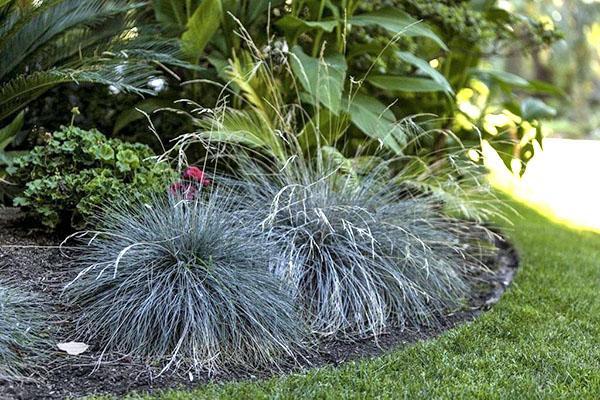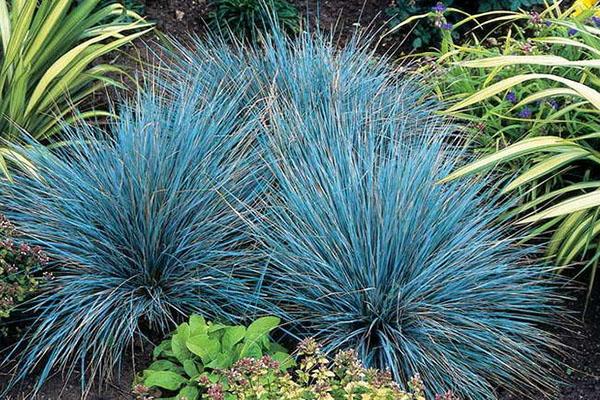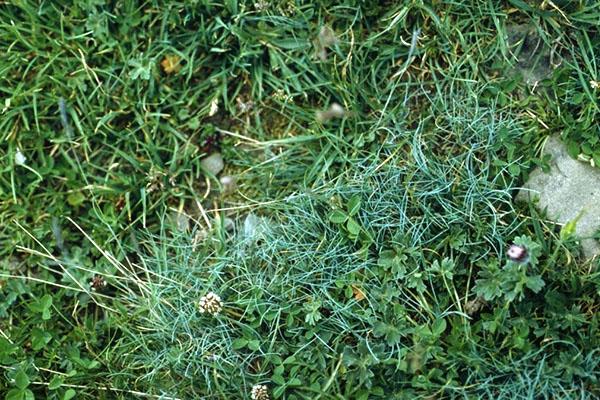Successfully growing fescue from seed
 Fescue is a beautiful herb with rough, needle-like leaves rolled into a tube. Growing fescue from seeds allows you to get a spectacular decoration of lawns thanks to decorative dense curtains that have an unusual appearance. The interesting texture of the leaves and the original shape of the plant itself are often used in landscape compositions, in rock gardens, carpet beds, pots and mixborders.
Fescue is a beautiful herb with rough, needle-like leaves rolled into a tube. Growing fescue from seeds allows you to get a spectacular decoration of lawns thanks to decorative dense curtains that have an unusual appearance. The interesting texture of the leaves and the original shape of the plant itself are often used in landscape compositions, in rock gardens, carpet beds, pots and mixborders.
Variety of varieties and types

In addition to gray, the following varieties are known:
- Mayra;
- glacial;

- valissian;
- Siberian;
- amethyst and others.
 Each of these plants has a distinct texture. Among them there are tall and short ones.
Each of these plants has a distinct texture. Among them there are tall and short ones.
Growing fescue from seeds
 Fescue is a perennial herb that is propagated by seeds and vegetatively. When dividing an adult bush, the separated parts can be transplanted to a new place. For this, a knife is not used, so as not to damage the plant and its roots. In this way, planting of fescue can be carried out both in spring and autumn.
Fescue is a perennial herb that is propagated by seeds and vegetatively. When dividing an adult bush, the separated parts can be transplanted to a new place. For this, a knife is not used, so as not to damage the plant and its roots. In this way, planting of fescue can be carried out both in spring and autumn.
How to grow fescue from seeds? There are several hundred seeds in 1 g of seeds. For example, gray fescue - about 950, paniculate - about 800. Seeds are collected after ripening and drying of panicle inflorescences.
Traditional way of growing
 Seeds are planted in the first half of March. Ceramic or plastic containers with low sides are suitable for germinating fescue.
Seeds are planted in the first half of March. Ceramic or plastic containers with low sides are suitable for germinating fescue.
The soil should be light, including:
- coarse sand;
- charcoal (crushed);
- deciduous and peaty land.
Prepared for planting substrate should be sprayed with a spray bottle, not watered. This is necessary to prevent excessive moisture.
 How to plant fescue seeds? The seeds prepared for planting are not deepened into the soil, but spread over the surface. Covering the container with glass or a transparent lid will help maintain adequate moisture. The lighting of the closed container should be good.
How to plant fescue seeds? The seeds prepared for planting are not deepened into the soil, but spread over the surface. Covering the container with glass or a transparent lid will help maintain adequate moisture. The lighting of the closed container should be good.
Germination and watering
The germination time of fescue depends on the conditions created. At room temperature, it is up to 20 days. After that, the container with seedlings is rearranged in a well-lit, but cooler place. Care should be taken with watering, since if it is oversupplied, seedlings may lodge and the roots may get wet.
Transplanting into open ground
When the grass grows 30 mm, a pick is made. Plants can be planted in separate pots one at a time or in several. When are fescue planted?
The most suitable time for transplanting into open ground is the month of May. When planting, keep the distance between plants from 20 to 25 cm.
Growing fescue from seed in cold greenhouses
 Another way to grow a plant from seed is in cold greenhouses. To do this, prepare the soil, loosen and spread seeds on its surface. The top is moistened with a spray.
Another way to grow a plant from seed is in cold greenhouses. To do this, prepare the soil, loosen and spread seeds on its surface. The top is moistened with a spray.
Germination takes place in 21 days if good lighting is organized. Sowing fescue seeds in a greenhouse is done at the end of March or later. The transfer of grown plants is carried out in stable warm weather.
Sowing seeds in open ground
 Fescue works well for creating garden compositions. The seeds can be planted directly in the open ground in a place designated for grass bumps. You can sow seeds in late March or early April when the weather is right.
Fescue works well for creating garden compositions. The seeds can be planted directly in the open ground in a place designated for grass bumps. You can sow seeds in late March or early April when the weather is right.
Before planting, the soil is prepared - loosened and slightly moistened. Seeds are planted, sprinkled with soil 20 mm. This approach prevents the soil from drying out, as well as the death of shoots. The distance between the individual holes should be about 20 cm.
Sowing is possible randomly in loose soil, followed by seeding with a rake.
Winter sowing
Another option for sowing seeds is before winter. To do this, choose well-lit areas that are not prone to flooding when snow melts and rains. The filling is carried out in the fall, in October. The seeds should not be deeply buried.
Due to the peculiarities of winter sowing, it is recommended to use the number of seeds 1.5 times more than with other methods. This is due to the fact that not all seeds will sprout after winter. By the next fall, the sown grass will form into decorative lush hummocks.
Additionally, in winter, it is advisable to sprinkle the areas with sown seeds with snow.
Requirements for growing conditions
 All fescue are sun-loving species. Warm sunny areas with good lighting are considered the most favorable for them, so they can be located on the south side of the building or rock garden... Partial shade and drafts can become an obstacle when growing a plant that cannot show its unusual colors and texture in all its glory.
All fescue are sun-loving species. Warm sunny areas with good lighting are considered the most favorable for them, so they can be located on the south side of the building or rock garden... Partial shade and drafts can become an obstacle when growing a plant that cannot show its unusual colors and texture in all its glory.
Fescue in planting and care is not demanding on the soil. It requires a light texture, looseness and lack of moisture stagnation. No nutrient soil is needed for fescue; dry, rocky soil with good drainage is the best option.
 Almost all plant species have high frost resistance, which allows it to tolerate winters well. After planting for 2 or 3 years, the curtains are prone to degeneration, which begins from the center of the hummock. Therefore, periodic renewal is necessary - replanting with seeds or dividing bushes.
Almost all plant species have high frost resistance, which allows it to tolerate winters well. After planting for 2 or 3 years, the curtains are prone to degeneration, which begins from the center of the hummock. Therefore, periodic renewal is necessary - replanting with seeds or dividing bushes.
In order for the cultivation of fescue from seeds to be successful, it is important when buying to choose species that are acclimatized to the conditions of the area.
 Dense, dense clumps-spheres of fescue with narrow leaves - one of the most popular crops among ornamental cereals. When sowing sunny flower beds with this plant, you can get a beautiful, spectacular garden design that does not require complex maintenance.
Dense, dense clumps-spheres of fescue with narrow leaves - one of the most popular crops among ornamental cereals. When sowing sunny flower beds with this plant, you can get a beautiful, spectacular garden design that does not require complex maintenance.